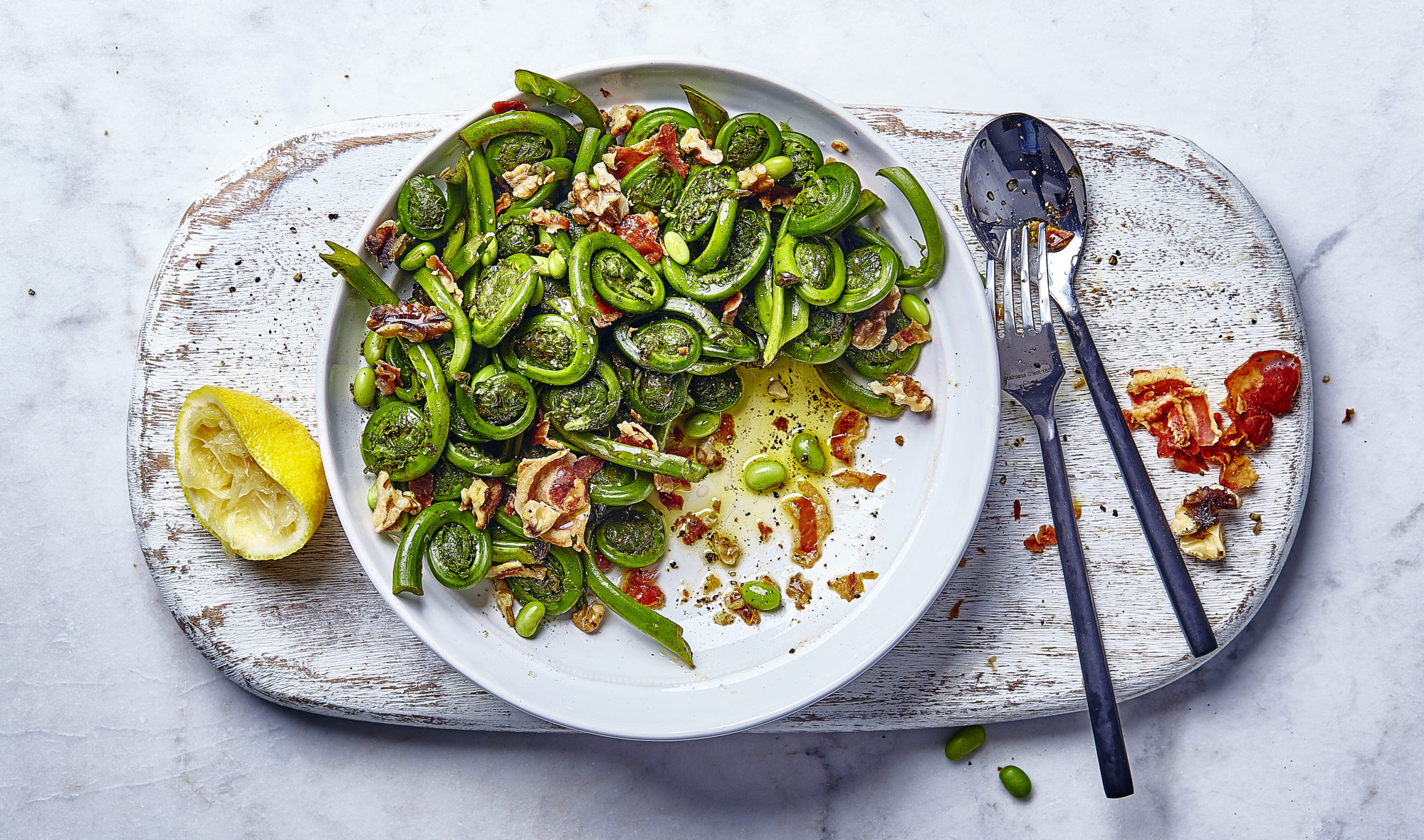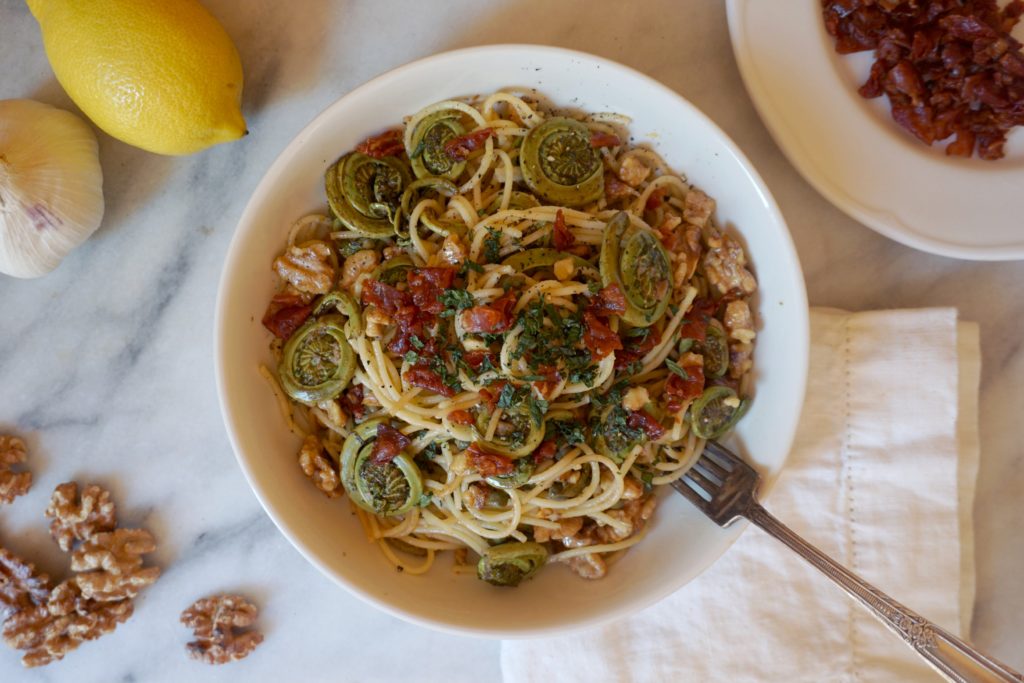
With a seasonal window lasting only a few weeks, fiddleheads are a rare and fleeting culinary delicacy. Fiddleheads are beautiful and delicious: Bright green fern fronds form an aesthetically inspiring spiraling disk. Taste-wise, fiddleheads have a refined, slightly bitter, slightly astringent taste reminiscent of asparagus. Fiddleheads are also nutritious, and are high in potassium, vitamin K, folate, and iron. A note of warning: Fiddleheads contain a toxic, naturally-occurring compound which gets destroyed when cooked sufficiently. If eaten raw or undercooked, fiddleheads can cause significant gastrointestinal distress. Health authorities suggest cooking fiddleheads at least 10-15 minutes.
Blink and you will miss the unique culinary experience of feasting on the furled fronds of the fiddlehead fern.
Having a season of only a few weeks, the fiddlehead is a wild crop that untucks itself from underground in late spring. Fiddleheads are harvested young, when the leaves and stem are still curled into themselves, forming a tightly spiraled disk. If allowed to mature, the green disks gradually unfurl themselves into the broadly splayed fronds of a typical fern.
Due to their short harvesting season, fresh fiddleheads are a rarity in North America and are therefore usually quite expensive and are considered a delicacy. In North America, fiddleheads are most likely to come from the Ostrich fern. Fiddleheads also grow in Europe and Asia.
It is recommended to cook fiddleheads well as they are known to contain toxic compounds that can cause symptoms of food poisoning if eaten raw. Health authorities advise boiling fiddleheads for 15 minutes, or steaming them for 10-12 minutes.*
The fiddlehead is called as such due to its resemblance to the carved, spiral head of a fiddle.
*Note: These recommendations are conservative and may result in overcooking. Culinary enthusiasts advocate fiddleheads be consumed slightly al dente and will likely recommend lower cooking times (6-10 minutes).
The fiddlehead is composed of a bright green frond tightly furled into a spiraling disk with a stem tail. If you look closely, you will see that the main frond is fringed with tinier fronds, also curled into themselves, making the fiddlehead a natural example of a fractal pattern.
Fiddleheads have a unique taste. They are bitter, astringent, and slightly smoky tasting, and borrow flavor profiles from both asparagus and broccoli.
100g of fiddleheads has 34 calories, 4.3g protein, 0.4g of fat, and 5.7g of carbohydrates. Fiddleheads are an excellent source of potassium, vitamin K, and folate, and a good source of iron.
Due to their short seasonal window, which, in North America, lasts only for a few weeks at the end of spring, fresh fiddleheads are hard to find.
When they are in season, you will most likely find them at larger grocery stores, health food stores, or fresh produce markets.
When choosing fiddleheads, look for specimens that are deeply green, firm, and tightly coiled with an inch or two of stem. The stem may be a little bit brown at the very tip, and there may be a brown, papery skin around the coil. Both of these things are normal, and can be removed prior to cooking. If the fiddleheads look slimy, wilted, mottled, or loosely coiled, pass them over.
You may also (albeit rarely) find fiddleheads either frozen, or pickled. Choose products with minimal/no extra ingredients.
Store fresh fiddleheads in a tightly sealed plastic bag in the fridge. Stored this way, they will last in the fridge for three to five days. Fresh fiddleheads are rich in tannins (like black tea) and may leak out a brown, watery liquid when stored in the fridge. This is normal. Just give them a rinse before cooking.
Fiddleheads can also be frozen, although it is suggested to blanch them before freezing in order to preserve their texture. You can do this by boiling the fiddleheads for two to three minutes, plunging them into cold water, draining them, and then freezing them in sealed bags. In the freezer, they will stay fresh for about six months. Recall that you will still have to cook them thoroughly when you are ready to use them from the freezer. Thawing prior to cooking is not recommended.
In order to eat your fiddleheads, do the following:
Option #1: Place fiddleheads in a steamer basket over boiling water and steam for 10-12 minutes (according to health authorities).
Option #2: Place fiddleheads in a pot of boiling water and boil for 15 minutes (according to health authorities).
Option #3: Place fiddleheads in a pan with a pat of butter or drizzle of olive oil and some chopped garlic, and sauté for about 7-10 minutes. Finish with a squeeze of fresh lemon juice, a sprinkle of salt, and a grating of parmesan.

Fiddleheads nestle into lemony, garlicky, buttery pasta, tossed with toasted walnuts and crispy prosciutto. Because fiddlehead season is so short you won’t be able to have this dish every day - so savor it while you can!
Prep Time: 15 minutes Cook Time: 25 minutes Yield: 4 servings
First, crisp the prosciutto: Place sliced prosciutto in a large non-stick pan over medium-high heat and cook, stirring frequently, until crispy, about 5-7 minutes. When crispy, remove prosciutto from pan onto a separate plate, and set aside.
Using the same pan, add butter and heat over medium-high. Add minced garlic, and cook until it begins to turn golden, about 1 minute. Add washed and trimmed fiddleheads to the pan and sauté for about 7-10 minutes, or until tender.
Once fiddleheads are cooked, reduce heat and add pasta, salt, capers, walnuts, lemon juice, and lemon zest to the pan and toss to combine.
Once all ingredients are combined, serve into individual bowls and top with parmigiano, fresh parsley, and crispy prosciutto. Season with a drizzle of good quality olive oil, and additional salt and freshly cracked pepper to taste, if desired. Enjoy!
Precision Nutrition’s Encyclopedia of Food expands every single month as we highlight new foods and showcase beautiful food photography. If you’d like to stay up to date, simply click this link. From there, we’ll send you a FREE copy of our recipe book. We’ll also let you know when new and delicious foods are added to the site.
With a seasonal window lasting only a few weeks, fiddleheads are a rare and fleeting culinary delicacy. Fiddleheads are beautiful and delicious: Bright green fern fronds form an aesthetically inspiring spiraling disk. Taste-wise, fiddleheads have a refined, slightly bitter, slightly astringent taste reminiscent of asparagus. Fiddleheads are also nutritious, and are high in potassium, vitamin K, folate, and iron. A note of warning: Fiddleheads contain a toxic, naturally-occurring compound which gets destroyed when cooked sufficiently. If eaten raw or undercooked, fiddleheads can cause significant gastrointestinal distress. Health authorities suggest cooking fiddleheads at least 10-15 minutes.